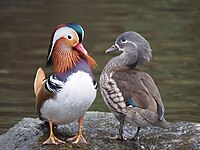
Photo from wikipedia
Animals select resources to maximize fitness but associated costs and benefits are spatially and temporally variable. Differences in wetland management influence resource availability for ducks and mortality risk from duck… Click to show full abstract
Animals select resources to maximize fitness but associated costs and benefits are spatially and temporally variable. Differences in wetland management influence resource availability for ducks and mortality risk from duck hunting. The local distribution of the Mallard (Anas platyrhynchos) is affected by this resource heterogeneity and variable risk from hunting. Regional conservation strategies primarily focus on how waterfowl distributions are affected by food resources during the nonbreeding season. To test if Mallard resource selection was related to the abundance of resources, risks, or a combination, we studied resource selection of adult female Mallards during autumn and winter. We developed a digital spatial layer for Lake St. Clair, Ontario, Canada, that classified resources important to Mallards and assigned these resources a risk level based on ownership type and presumed disturbance from hunting. We monitored 59 individuals with GPS back-pack transmitters prior to, during, and after the hunting season and used discrete choice modeling to generate diurnal and nocturnal resource selection estimates. The model that classified available resources and presumed risk best explained Mallard resource selection strategies. Resource selection varied within and among seasons. Ducks selected for federal, state and private managed wetland complexes that provided an intermediate or relatively greater amount of refuge and foraging options than public hunting areas. Across all diel periods and seasons, there was selection for federally managed marshes and private supplemental feeding refuges that prohibited hunting. Mallard resource selection demonstrated trade-offs related to the management of mortality risk, anthropogenic disturbances, and foraging opportunities. Understanding how waterfowl respond to heterogeneous landscapes of resources and risks can inform regional conservation strategies related to waterfowl distribution during the nonbreeding season.
Journal Title: Ecology and Evolution
Year Published: 2019
Link to full text (if available)
Share on Social Media: Sign Up to like & get
recommendations!